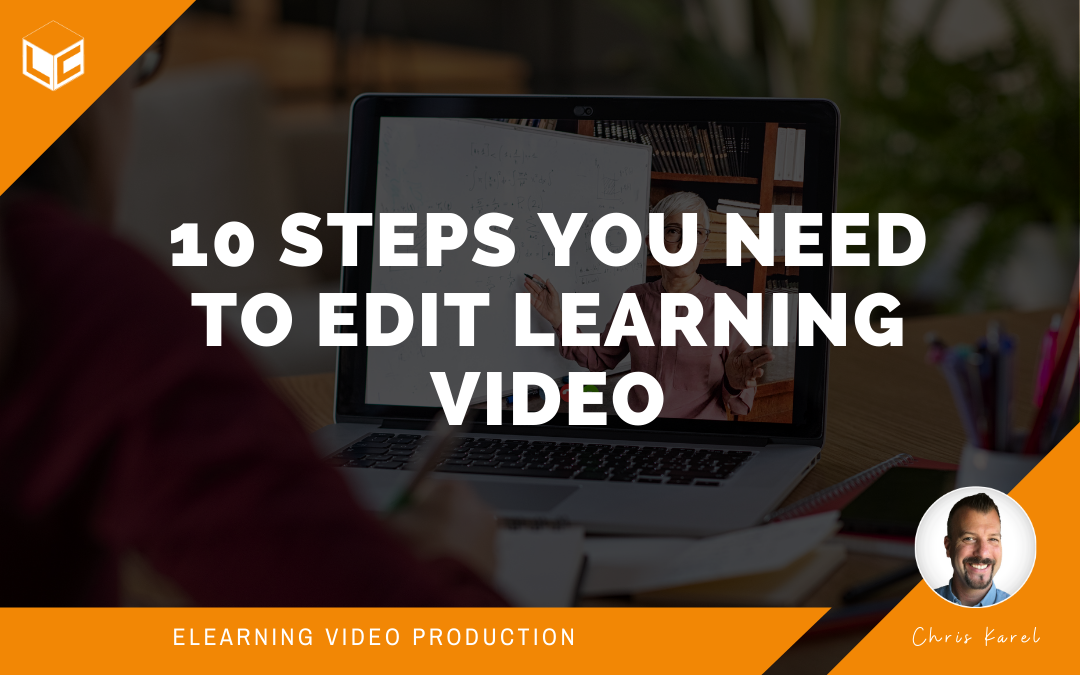I’m on a mission to help people make and use video for learning purposes. To edit learning video like a professional you need a checklist. Professional editors plan, edit, and share. This post focuses on the ten things you need to do to edit your video. You should only take these 10 steps after you have effectively planned out the learning video. In other words, this post assumes you have conducted a needs analysis, spent time scriptwriting, completed video pre-production, and recorded footage like a professional. It also assumes you have planned your edit by following the pro-tips related to planning an edit.
Editing is where you determine if you will actually improve knowledge, skills, and behaviors!
~ Chris Karel
So let’s get to it!
10 Steps You Need To Edit Learning Video
Editing video is one of several processes you need to learn if you are to truly become a KSB master. Editing video is a linear process. Begin with folder organization and end with the way it looks. Follow the ten steps below and you will own that KSB promise. You will help your learners improve their knowledge, skills, and behaviors.
Make folders
Create a main folder for your project on your computer. Then, create subfolders within that main folder where you’ll store (and easily find) everything you’ll need for editing. Check out the screencap for an idea of the set up I use. There should be a subfolder called Assets where you’ll have sub-sub folders for your video clips, audio files, photos, and graphics. Your next subfolder will be for Documents, where you’ll keep your scripts, shot lists, and storyboards in their own sub-subfolders. Then, create a subfolder for Exports, where you’ll store your final edited files. Finally, the last subfolder you need to create is for your Project Files – these are the files that get created by your editing software.

Organize
Now that you have your folder structure, start putting stuff in it! Organize your “assets” into the folders you created. To repeat, an “asset” is any kind of media you will use in your video: audio narration, video clips (both a-roll and b-roll), images, icons, music, and sound effects.
Make a selects sequence
Now that you’re organized, you can start reviewing your video footage for the best takes. When you locate a good clip that you’ll want to use, drag it onto a track on your video editor’s timeline to create a “selects sequence.” Don’t worry too much about getting everything in perfect order yet – this is just to make sure you have your best clips at hand while you edit the learning video.
Create a rough cut
Look at your storyboard or script and assemble the video in the sequence that the writer intended. Use the best of the best clips from your selects sequence to string together your “rough” (aka first draft) version of the final video. Avoid music, titles, graphics, and photos at this point. When you put those in too early, they can be a pain to tweak/fix if and when you need to make major edits to your rough cut.
Trim the rough
Watch your rough cut several times. Try to cut down on the wasted time where there’s no action or the actor is not talking. The trimming process is often what people think of as editing. You will be trimming the clips so that only the parts needed for the final story are left on the timeline.
Use b-roll to cover your story
Once your rough cut is solidified, add b-roll or other video that does not feature the actor(s) talking. Use shots of the scene or actions to cover the cuts, make things flow and add visual interest. For example, it’s common to cut from someone talking to show a close-up of their hands. You may also use b-roll of a prop to highlight the story if the actor references that prop during their dialogue.
Add graphics, music, and sound effects
It’s time to add the sprinkles to your video sundae. Add the titles, graphics, icons, music, and sound effects. Unlike my own use of sprinkles on my favorite ice cream, use each of these sparingly. Avoid putting music under the teaching portions of the video. Reserve music for your intro/outro sections or when you are changing scenes.
Add transitions
Transitions are subtle animations that help visually tie separate video clips together. There are many different types built into your editing software, but I recommend keeping your transitions fairly basic: cut, dissolve, or a wipe. The most common is a cut, and just by trimming and placing your video clips in a sequence, you’ve already placed those in your video at this point. Look for places where a dissolve or a wipe may help the viewer engage from one scene to the next.
Normalize the audio
Now that the visuals are locked into place, you want to normalize the audio. This simply means getting all of the clips to a similar volume from the beginning to the end of the video. Sudden volume changes can distract viewers. The overall mix should span from –6db to -20db. Dialogue sounds good at –6db to -12db. Music should be at the-14db to -20db level and sound effects should stay between-15db to -24db with occasional spikes up to -7db.
Color correct
Correcting the color in your video at the most basic level means making sure that pure white is the same from one scene to the next. If not, this can also distract your viewer and “take them out” of the world of your video. Here are some tutes to help you with this step:
How to Color Correct Video (The 101 Guide!) – YouTube
How To Color Correct Videos FAST! (All Major Editing Software)
What’s next? Once you have completed these 10 steps to edit learning video like a pro it’s time to export or share a version of your video with your learners.
Helpful Links
Video Editing Workflow: How to Do it Properly
The Ultimate Checklist for Video Editing Basics
4 Tips to Improve Your Video Editing Workflow
Summary
Video editing can be overwhelming and frustrating if you do not take the time to organize…and stay organized. As you edit more and more learning videos, you will find ways to improve your workflow using new skills. Staying consistent in your process helps you produce high-quality deliverables for your learners. It’s important to take the editing process one step at a time, as each part of the process builds on the ones that come before. Before you know it, you’ll have an amazing learning video delivering on that KSB!
Join my learning pals
How do you stay organized during your editing sessions? Share your voice with me.
Join my learning pals. Please subscribe to my newsletter to receive free learning resources delivered to your inbox every two weeks.
THE END













